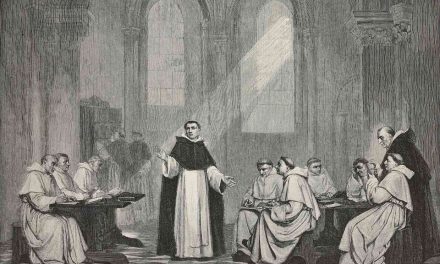I decided to join the Catholic Church in 1999, during my sophomore year at Hendrix College, a Methodist college in central Arkansas. The college required students to take two religion courses, and so in my freshman year I took a two part course on the History of Christianity taught by Dr. John Farthing, a now-retired church historian and Methodist minister. Although I entered college a Methodist, this course led me to explore the controversies and characters of the Christian tradition, a process that led me to the Catholic Church.
Not only did my Methodist college lead me to the Catholic Church, it also provided me with my first encounter with the Second Vatican Council, whose fiftieth anniversary we are celebrating this year. As a religion major at a Protestant college, most of my theological education focused on figures like Luther, Wesley, Schleiermacher, and Niebuhr. In my senior year, however, I had the opportunity to take a course on Modern Roman Catholicism, also taught by Dr. Farthing. Of course I had learned some of the teachings of the council during the process of initiation into the church and through my own studies, but it was in this class that I first read and studied the major documents of the council.
I dutifully carried my bright yellow and blue Flannery edition of the Vatican II documents back and forth from my dorm room to the classroom. Although he surely must have read the documents many times before, Dr. Farthing radiated delight at what he found in them, perhaps dispelling the dark perceptions of the Catholic Church instilled in his own Pentecostal childhood. The warmth and humanism of the documents immediately appealed to me, especially the theological vision of the human person presented in Part I of the Pastoral Constitution on the Church in the Modern World, Gaudium et Spes. The universal call to holiness proclaimed in the Dogmatic Constitution on the Church, Lumen Gentium, helped me understand my own vocation as a recently “converted” lay person searching for an identity.
What was not evident to me at the time, though, but is obvious now, is how much my own theological journey was made possible by the church emerging from Vatican II. Obviously many people, myself included, have been drawn into the post-Vatican II church who would not have been so attracted to the pre-conciliar church, but that is not really what I mean here. What I mean is that the profound efforts at ecumenism opened up by the council’s Decree on Ecumenism, Unitatis Redintegratio, made it possible for me to discover Catholicism and to live out my faith in the way that I have.
Dr. Farthing pointed out to us how Unitatis Redintegratio speaks of Protestants as “separated brethren” rather than “heretics” or “schismatics.” Among baptized Christians, our shared brotherhood and sisterhood in Christ is more fundamental than what divides us. While pointing out the serious issues of disagreement, the document insists that Protestants’ baptism, worship, faith, prayer, and devotion to Scripture are all sources of authentic grace, a statement that parallels Lumen Gentium’s claim that “many elements of sanctification and of truth” are found outside the visible structure of the Catholic Church (#8).
Growing up in Arkansas, Catholicism seemed foreign. I only knew a handful of Catholics, and before college I had only stepped foot in a Catholic Church once, for a friend’s birthday party (I remember being uncomfortable with the prominent statue of St. Jude). That I would later become a Catholic, let alone a Catholic theologian, was unthinkable.
As foreign as Catholicism had seemed, however, as I truly encountered it in my study of Christian history and theology, I discovered that what it asked of me was not at all foreign to what I had experienced as a Methodist. My Methodist education exposed me to the powerful thinkers of our shared Christian tradition, especially St. Augustine, whose Confessions was instrumental to my journey. My love of Scriptures goes back to childhood Sunday mornings of paging through the Bible instead of paying attention to the sermon. And I am certain that what ultimately drew me to Catholicism, the richness of the moral and devotional life found in its traditions, was so decisive for me precisely because of the centrality of holiness and Christian perfection in the Wesleyan tradition in which I had been raised. It was precisely those graces recognized by the council that made possible my journey from Methodism to Catholicism. A Catholicism that could not recognize this shared grace would be impossible for me.
Lately my mom, who remains a Methodist, has begun to explore praying with beads, devotion to the saints, and the contemplation of icons as spiritual practices. She tells me that she feels more comfortable telling me about the excitement she feels at her discovery than she does many of the people in her own church, who see these traditionally Catholic and Orthodox practices as foreign. She is comfortable because I can understand how she experiences them as a source of grace in her life, but I also understand that for her it is an experience of grace still rooted in her own church, the Methodist church. What in the past would probably have divided our family, has, because of Vatican II, become shared grace for us.
Now as a professor of theology at a Catholic college, whenever we study the great theologians of the Protestant tradition, like Luther and Wesley, I try to communicate to my students the truth and beauty in their witness to the Gospel. I also suggest that Catholics might have a thing or two to learn from them, just as I did on my journey to Catholicism. My purpose is not to turn my students into Protestants, but to lead them to encounter the vision of shared grace presented by the Second Vatican Council that made my own Catholic faith possible.




Thanks for this reflection, Matt. It’s wonderful to the see the theology of the council so beautifully rendered through experience. Sometimes it is hard to communicate to students who weren’t around before the council (I wasn’t either!) how much things have changed. I’d like to have them read this along with some of the anti-Protestant rhetoric in the manuals of moral theology.